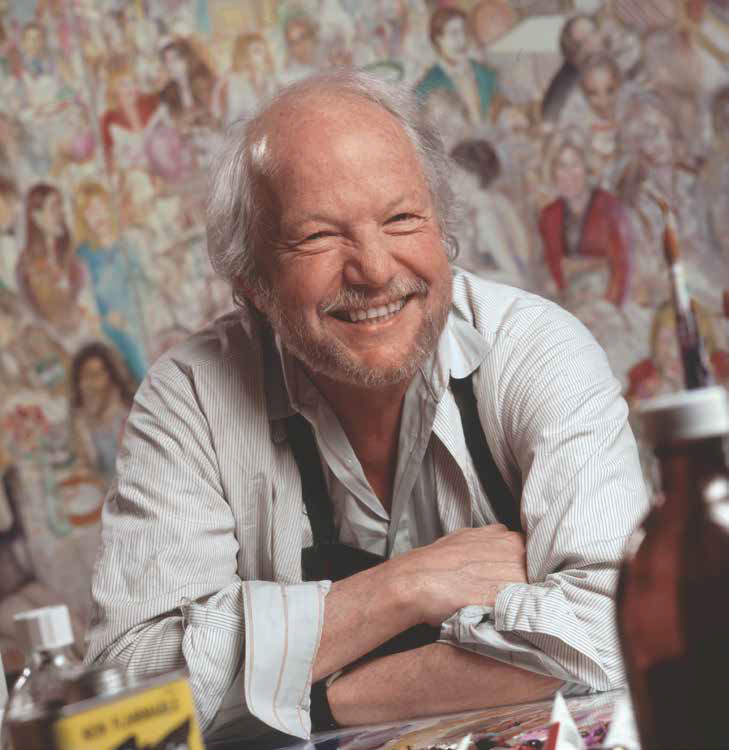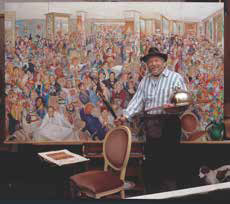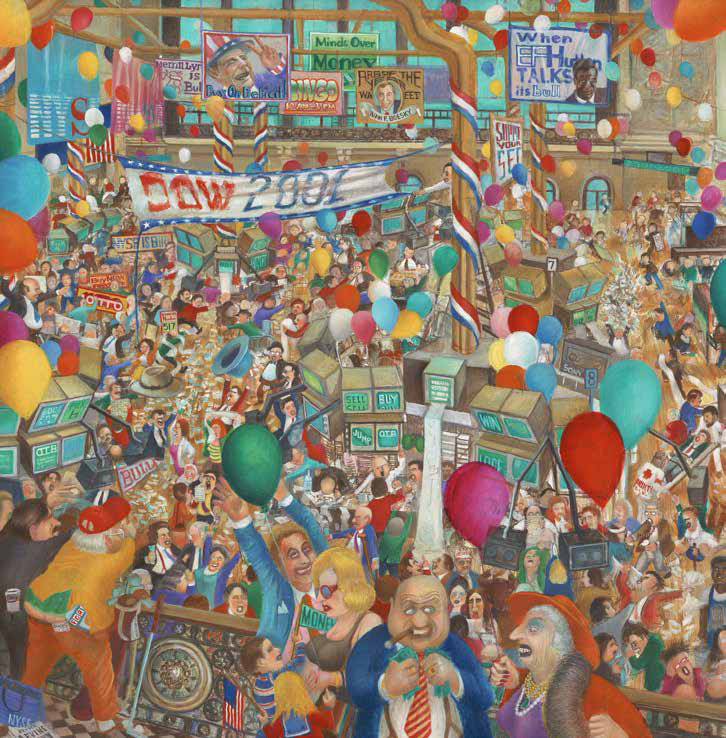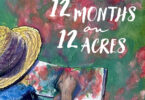(And we need him…)
Robert Cenedella has been away, in a manner of speaking. At least to me. No, he didn’t stop painting, leave town, or give up his studio, or fold his easel and stash it in the corner with a sheet over it. He was working on something else over the past couple of years, a different kind of project than his artwork, and he has decided that he’s finished with it. I wish I could now commission him to turn out a new painting every month or so, continuing to demonstrate how much we need to get to work on ourselves, collectively, morally. That’s what Cenedella does with his paintings. Cenedella is a moral man. We need him in these amoral times. Cenedella is an honorable man, and I won’t hesitate to praise him.

Robert Cenedella is not somebody you forget easily, either from meeting in person, or after seeing his paintings. When meeting him in person, one is struck by the strong physical presence: tall, stout, with a deep resonant voice. Well planted on the Earth. He speaks softly and clearly; one listens. You may feel that his eyes look at you warily at first, but then soon you detect the playful twinkle working within. One would not automatically assume that the man has a rebellious nature and cultivates the persona of the curmudgeon, the artistic bad boy, the cage-rattler. He is a jovial people-person, maybe a little bit like the free-thinking uncle some of us have been lucky enough to have. He is quick and certain in his opinions of the world and his place within it. And yes, he
continues to have a long and successful career as an artistic master of satire. It’s not what he does; it’s what he is.
I first met Mr. Cenedella at an opening he was having at the Cornelia St. Café, almost two years ago. This is the kind of place where he likes to show his work: small, lively and convivial, rather than in the chilly-white atmosphere of the commercial art venue. The gallery space at Cornelia St. was completely packed with friends and well-wishers, and full of energy. I realized I had actually seen Cenedella’s work before, having been amused and admiring of his well-known crucified Santa Claus image. But seeing it at the Cornelia Street opening, the connection between this image, the man, and his other artwork suddenly became clear. I was fascinated by the other paintings on display there, which were very much in his style of hallucinogenic imagery, often packed with large numbers of figures, reminiscent of James Ensor or perhaps even Hieronymus Bosch, but of recognizable contemporary people, frequently engaged in some kind of questionable pursuit. Fascinated, I wanted to see more. Mr. Cenedella graciously invited me to visit him at his studio in Manhattan.

There in his studio, classical music blasted out at a volume that made conversation impossible until he turned it down. He provided me with copious articles that others had written about his artwork over the years. A new painting rested on his easel; others leaned Cenedella against the walls. We chatted not only about his painting, but several other projects he had worked on over the years. The conversation centered on his continued ‘outsider’ status as a painter, and how he has been largely ignored by what can be called ‘the art establishment.’ He lamented that none of his paintings were currently in any major museum and that the auction houses, which generally provide the benchmark for the value of an artist’s work, had not picked up on any of his offerings or sales. A shame in one way, since satire in painting has always had great relevance to our society and the world. Self-reverential, they are not. But they satirize politics, pompous celebrities, the vacuousness of art-world tastemakers and people with more money than brains. I can’t picture the art establishment welcoming him with open arms, if at all. Cenedella is, and always will be a rebel. Good! That’s his real job. As a rebel, he is absolutely a role model. But rather than talk at length here about his career and history as a painter, I want to mention three of his alternative projects which demonstrate other ways in which he has been in touch with the times in which he lives, and what that signifies.
The first project was his personal attempt to illustrate (and to participate in) the growing commodification of artwork, in which an artwork’s value is subverted by its cost. The year was 1965, and Cenedella called the exhibition “Yes Art”, and he was also open to the possibility that it would become a ‘movement’. He occupied a gallery on Madison Avenue for six weeks (at a time when Warhol had just begun offering his faux Brillo box objects), and sold real Brillo boxes, courtesy of the Brillo company, signed and numbered, and priced at a discount if the buyer folded and assembled the box themselves. He also gave away real S & H Green stamps with the sale of artwork (courtesy of the S & H Company), and also sold numerous other items which he did not hesitate to call ‘jokes.’ The show gained him a lot of attention, but Cenedella’s satire took a literal and personal turn when shortly after the “Yes Art” exhibition, he left the art world for ten years to become a successful graphic designer, producing countless iconic posters which I remembered clearly from my youth. I was astounded to learn that Cenedella was behind them. This was all part of a plan, since he said that before he ‘retired’ from the fine art world, he wanted to go out with a bang…..
The second project, from 1986, in the middle of a period of financial boom, was a more ambitious attempt to further reflect on artwork’s new dual role as both art object and commodity, in a literal way. Cenedella brilliantly combined these roles in a timely way, cleverly offering shares in a painting called “2001: A Stock Odyssey,” to investors who would receive a bonus payback once the painting was sold at a high price. He got a lot of enthusiastic notice on this project, with articles appearing as frequently in financial journals as in the art press. Although the 80’s might be remembered as the ‘Greed is Good’ decade (think of Ivan Boesky), investing in art in this way perhaps did not sufficiently inflame the lusts of those who wanted a quicker and more lucrative payoff, and the experiment’s conceptual daring was not repeated. The idea still seems viable to me, and I am surprised that no one else has ‘capitalized’ on it.
The third and most recent project seemed much less of an artistic project than a
self-conscious social project: Cenedella’s museum conspiracy lawsuit of 2018, alleging that certain museums had consciously made moves to keep Cenedella’s paintings out of their collections and off their walls. I was a bit puzzled by this change in creative tactics, and where he wanted to go with it. Once again Cenedella demonstrated his predilection to be a man of his times, those
times now being such that extended fighting in court takes the place of common concern and interpersonal discourse. His suit, though, never came to trial, a presiding judge deciding it was too difficult to prove. Cenedella was left with the option of refiling the case in different form, if he later decided to do so. But if this project was intended to have a ‘creative’ component, then something was missing, something essential to Cenedellaism. It is rather more difficult to satirize something you are participating in. When we spoke about it, his normal sharp sense of wit and mastery seemed to be missing. I felt that somehow, Cenedella the satirist had been co-opted and sucked in by evil forces beyond him.
He was an individual trying to play a corporate game he likely could not win; like a jester, but without real jesting, only blurred pantomime……….. In the lawsuit, irony and humor had necessarily been abandoned. It had no more slyness than a judge banging his gavel with finality; less even than Donald Trump glowering at the camera and growling, “You’re fired!”
Sometime shortly after my studio visit with Cenedella, I learned that my application to work as an art handler for one of the large arts auction houses had been accepted. I mentioned this to Cenedella and I suggested that I was about to enter the belly of the beast. I told him that it might be difficult for me to
continue with the article during my temporary employment period of five months. He joked with me, “If you don’t think you want to work there, I’d be happy to give you a recommendation that will guarantee you’ll be heading back
out the door again right away. Just mention my name and see what happens.”
He didn’t need to. It didn’t take long to see how things worked there. Art equaled money. Or rather, they weren’t equal; money was much more important. Their mission was to turn artwork into as much money as possible.
Since the art-selling industry is unregulated, they are very clever at coming up with ways to improve their financial results, not all of which are legal. Even Trump couldn’t resist opportunities to finagle at one local auction in the
Hamptons. He hired a fake bidder to bid up the price of a portrait of himself, to guarantee that it would end up being the highest priced work in the sale. Yikes.
As a worker at the very bottom of the pole, however, I spent little time worrying about the CEO, and more time worrying about how I would get enough sleep,
since I was subject to ‘mandatory overtime.’ Sixty to seventy hour weeks were normal, and my personal best was 84 hours. My co-workers would joke that going home at 5:30 p.m. was ‘half a day.’ In my ‘temp’ contract, I had signed
all of my rights away, except for that of quitting without notice. And please allow me to also mention the punitive management style; a class-attitude worthy of 18th century England, (when the business was originally founded);
rodent-infested locker rooms; huge turnover and overall bad morale. I felt like my five months was more of a sentence than a trial period. No sour grapes, though; I learned what I needed to…

Afterward, it took me a long time to get back to this article about Cenedella, but I thought of him and his critical abilities often. He clearly had gotten under my skin. Every time I went to the computer, however, to continue this article where I
had left off, there was more news about American politics that was astonishing, flabbergasting and dreadful. I would read ravenously for a day about the insanity emanating from our government, and then immediately become a horrified recluse, not turning on the computer for days or even weeks at a time. Somehow I kept hoping that things would get better. Sometimes it seemed
difficult to even define ‘better.’ Points of reference had been lost. Where the heck was Cenedella when we needed him?
Then at last, one day earlier this year, as I sat at the computer trying once again to shake Cenedella back to life in my mind, I came across something about him that I was overjoyed to see, a very small, single reference on the Internet, stating simply, “Artist decides not to pursue court case.” Ironically, and I think Cenedella would appreciate this, the announcement was in an obscure law journal, not in an art magazine or newsletter. The announcement was simple, but it gave me a great lift to hear that Cenedella would not be taking up his option to refile his suit, that he would not be taking up his very precious time with lawsuits. As the critic Ed McCormack once told him, “When your work speaks for itself, don’t interrupt.” Out of the courts and back in the studio, Bravo! We need Cenedella on the firing line now more than ever. His paintings are so good, so pointed in their ability to show us exactly what is wrong with not just the government and the art business, but many of our attitudes and opinions, and even with this country itself. We need Cenedella fighting in the trenches; we need Cenedella doing what he does peerlessly. Which is showing us clearly what and who is acting stupidly, dangerously and greedily, even if it might be, at the core, all of us. This is what he does best, does so clearly, easily, and to my mind, importantly. Too bad we can’t clone him…
Art, according to current wisdom, has lost its power to influence society. But that doesn’t mean it has lost its power. In this way, Cenedella goes beyond what countless other artists do. He gives it context. I recall Pete Seeger talking about music and saying, “Don’t ask if the music is good, but rather what is the music good for.” The same could be said about Cenedella’s painting.





Leave a Comment